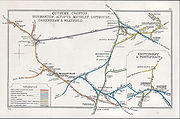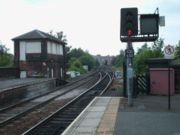
Castleford railway station
Encyclopedia


Castleford
Castleford is the largest of the "five towns" district in the metropolitan borough of the City of Wakefield, in West Yorkshire, England. It is near Pontefract, and has a population of 37,525 according to the 2001 Census, but has seen a rise in recent years and is now around 45-50,000. To the north...
in West Yorkshire
West Yorkshire
West Yorkshire is a metropolitan county within the Yorkshire and the Humber region of England with a population of 2.2 million. West Yorkshire came into existence as a metropolitan county in 1974 after the passage of the Local Government Act 1972....
. It lies on the Hallam
Hallam Line
The Hallam Line is the name given to rail services operated by Northern Rail, in the West Yorkshire Metro/ Travel South Yorkshire area of northern England which connect Leeds and Sheffield via Barnsley. It is the slower of the two routes between Leeds and Sheffield, with faster services provided...
and the Pontefract
Pontefract Line
The Pontefract Line is the name given to one of the rail services in the West Yorkshire Metro area of northern England. The service is operated by Northern Rail, and links Wakefield and Leeds with Goole via Pontefract...
Lines 11 miles (17.7 km) south east of Leeds.
Although originally built as a through station, regular passenger services beyond Castleford towards York
York railway station
York railway station is a main-line railway station in the city of York, England. It lies on the East Coast Main Line north of London's King's Cross station towards Edinburgh's Waverley Station...
were discontinued in January 1970. Today, all services reverse in the station, arriving and departing from a single platform. Freight traffic runs through the station. The footbridge
Footbridge
A footbridge or pedestrian bridge is a bridge designed for pedestrians and in some cases cyclists, animal traffic and horse riders, rather than vehicular traffic. Footbridges complement the landscape and can be used decoratively to visually link two distinct areas or to signal a transaction...
and platform 2 are currently disused, although platform 2 was brought back into use temporarily during the Leeds First
Leeds City railway station
Leeds railway station is the mainline railway station serving the city centre of Leeds in West Yorkshire, England...
project in 2002 when Transpennine services between York and Huddersfield
Huddersfield railway station
Huddersfield railway station serves the town of Huddersfield in West Yorkshire, England.The station is managed by First TransPennine Express who provide trains between the North East, North and East Yorkshire, and Leeds to the east and Manchester Piccadilly and North West.It is also served by local...
were diverted to avoid engineering work in Leeds, routed via Church Fenton
Church Fenton railway station
Church Fenton railway station serves Church Fenton in North Yorkshire, England. It is situated on the former York and North Midland Railway main line from York to Normanton, just under from York.- History :...
, Castleford and Wakefield Kirkgate
Wakefield Kirkgate railway station
Wakefield Kirkgate railway station is a railway station in Wakefield, West Yorkshire, England. Unlike the nearby Wakefield Westgate railway station, Kirkgate is unstaffed and served mostly by local trains...
. Platform 2 may also be brought back into use on a more permanent basis to help accommodate extra peak hour services if Network Rail proceed with plans mooted in the recent Yorkshire & Humberside RUS.
The route from Church Fenton continues to be used for such engineering and other out-of-course diversions as required (such as in the summer of 2008, when all Sunday services between Leeds and York/Hull were routed that way due to work near Micklefield).
Metro, the West Yorkshire Passenger Transport Executive
West Yorkshire Passenger Transport Executive
The West Yorkshire Passenger Transport Executive is the Passenger Transport Executive for the county of West Yorkshire, England. It is the executive arm of the West Yorkshire Integrated Transport Authority and was originally formed on 1 April 1974 as the West Yorkshire Passenger Transport...
, has been developing plans to relocate Castleford bus station
Castleford bus station
Castleford bus station serves the town of Castleford, West Yorkshire, England. The bus station is owned and managed by the Metro .The bus station is situated in Castleford Town Centre off Albion Street and is approximately 100 metres away from the town's railway station.There are 15 stands on four...
to a new site next to the railway station, and to create a fully integrated and staffed transport interchange. Provisional approval for the £14.5 million project was granted in December 2004, with works due to be completed by 2011.
History
The current station was built by the North Eastern RailwayNorth Eastern Railway (UK)
The North Eastern Railway , was an English railway company. It was incorporated in 1854, when four existing companies were combined, and was absorbed into the London and North Eastern Railway at the Grouping in 1923...
in 1871 to replace an earlier one 440 yards (402.3 m) to the east built by the York and North Midland Railway
York and North Midland Railway
The York and North Midland Railway was a railway company in the United Kingdom which opened in 1839, connecting York, with the Leeds and Selby Railway and in 1840 with the North Midland Railway at Normanton near Leeds.-Origins:...
on their line from York to Normanton
Normanton railway station
Normanton railway station serves the town of Normanton in West Yorkshire, England. It lies south-east of Leeds railway station on the Hallam Line, which is operated by Northern Rail.-History:...
and opened on 1 July 1840. A short time later an east to north curve was constructed between Whitwood and Methley
Methley
Methley is a dispersed village in the City of Leeds metropolitan borough, south east of Leeds, West Yorkshire, England. It is located near Rothwell, Oulton, Woodlesford, Mickletown and Allerton Bywater. It nestles in the triangle formed by Leeds, Castleford and Wakefield, and is between the...
junctions (the latter on the North Midland Railway
North Midland Railway
The North Midland Railway was a British railway company, which opened its line from Derby to Rotherham and Leeds in 1840.At Derby it connected with the Birmingham and Derby Junction Railway and the Midland Counties Railway at what became known as the Tri Junct Station...
main line) to create the first through route between York and Leeds – it would remain the primary route between the two cities until 1869 and also carry services between Leeds and Hull for a number of years thanks to the machinations of George Hudson
George Hudson
George Hudson , English railway financier, known as "The Railway King", was born, the fifth son of a farmer, in Howsham, in the parish of Scrayingham in the East Riding of Yorkshire, north of Stamford Bridge, east of York. He is buried in Scrayingham...
.
The town gained a second station at Cutsyke in 1860, courtesy of the Lancashire and Yorkshire Railway
Lancashire and Yorkshire Railway
The Lancashire and Yorkshire Railway was a major British railway company before the 1923 Grouping. It was incorporated in 1847 from an amalgamation of several existing railways...
whose line from Pontefract Monkhill to Methley Junction (and hence Leeds) had opened in 1849 and passed over the Y&NMR line near Whitwood Junction. Further construction work by both companies saw lines built to Lofthouse
Lofthouse, West Yorkshire
Lofthouse is a village in West Yorkshire, England between the cities of Wakefield and Leeds. It is in the City of Leeds metropolitan borough but with a Wakefield postal address . It is mentioned as Locthuse also Loftose in the 1086 Domesday Book....
(on the main line from Wakefield Westgate to Leeds) via Stanley
Stanley, West Yorkshire
Stanley is an area in the Metropolitan Borough of Wakefield in West Yorkshire, England. It is about north-east of Wakefield city centre.Stanley was an Urban District in the West Riding of Yorkshire prior to 1974, being made up the four electoral wards of Lake Lock, Outwood, Stanley and Wrenthorpe...
(the Methley Joint line) in 1865 (1 May 1869 for passenger traffic), to Garforth
Garforth railway station
Garforth railway station serves the town of Garforth, near Leeds in West Yorkshire, England. It lies on the York and Selby Lines and North TransPennine routes. Garforth is east of Leeds....
via Ledston
Ledston
Ledston is a village and civil parish north of Castleford and east of Leeds in the county of West Yorkshire, England. The village is in the City of Leeds metropolitan borough...
in 1878 (giving passengers the choice of no fewer than three alternative routes to Leeds) and a curve linking the Y&NM and L&Y routes in the town two years later. This latter piece of line was seldom used for much of its life (and was closed on two different occasions) but now forms an important part of the line towards Knottingley.
Thus by the end of the nineteenth century the station (by now known as Castleford Central) had an impressive range of services to choose from, with regular links to Leeds, Wakefield and on towards Manchester Victoria through the Calder Valley as well as to York. Longer distance destinations (including Sheffield, Derby, Birmingham and London) were also available by means of a change at Normanton.
By the early 1950s however the local network began to decline, with the Garforth line the first to lose its passenger trains on 22 January 1951. The Methley Joint line fell victim to the Beeching Axe
Beeching Axe
The Beeching Axe or the Beeching Cuts are informal names for the British Government's attempt in the 1960s to reduce the cost of running British Railways, the nationalised railway system in the United Kingdom. The name is that of the main author of The Reshaping of British Railways, Dr Richard...
on 2 November 1964 whilst the L&Y station at Cutsyke suffered a similar fate on 7 October 1968 – trains from Pontefract thereafter using the aforementioned curve to reach Central, where they reversed before continuing to Leeds via Whitwood Junction (although the direct line remained in use for freight until 23 February 1981).
Another significant change was the withdrawal of services on the original Y&NMR line between York and Wakefield on 5 January 1970, leaving the station to be served only by trains on the Pontefract line
Pontefract Line
The Pontefract Line is the name given to one of the rail services in the West Yorkshire Metro area of northern England. The service is operated by Northern Rail, and links Wakefield and Leeds with Goole via Pontefract...
(although a handful of summer dated trains from Wakefield to York and Scarborough
Scarborough railway station
Scarborough railway station serves the seaside town of Scarborough in North Yorkshire, England. It lies east of York and is one of the eastern termini on the North TransPennine route operated by First TransPennine Express...
continued to run until the mid 1980s) and creating the current situation where all scheduled trains calling there approach from the west, use a single platform and have to reverse to continue their journeys. One more positive development was the re-routing of trains on the Hallam line
Hallam Line
The Hallam Line is the name given to rail services operated by Northern Rail, in the West Yorkshire Metro/ Travel South Yorkshire area of northern England which connect Leeds and Sheffield via Barnsley. It is the slower of the two routes between Leeds and Sheffield, with faster services provided...
via the town in 1988, which reinstated the link with Wakefield and also gave passengers access to direct trains to Barnsley and Sheffield.
Services
Monday to Saturdays, there is a half-hourly service from Castleford to Leeds with an hourly service to Sheffield via Barnsley (Hallam Line) and an hourly service to KnottingleyKnottingley railway station
Knottingley railway station serves the town of Knottingley in West Yorkshire, England. It lies on the Pontefract Line, operated by Northern Rail, and is south east of Leeds railway station....
(Pontefract Line).
On Sundays there is an hourly service to Leeds and a two-hourly service to both Sheffield and Knottingley.

